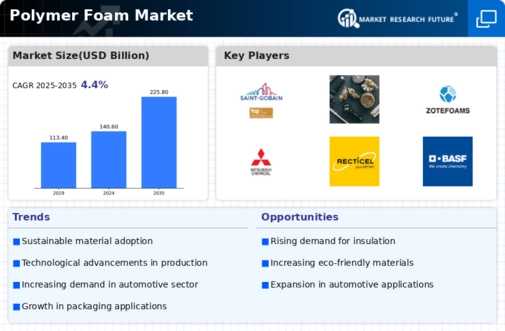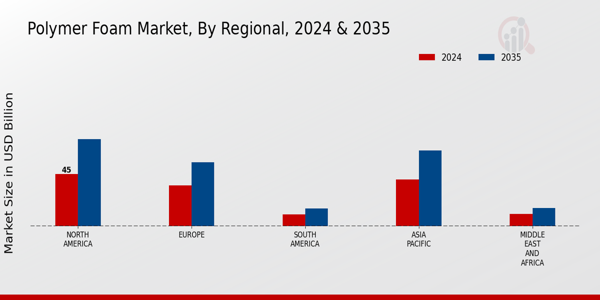-
EXECUTIVE SUMMARY
-
Key Findings
-
Market Segmentation
-
Challenges and Opportunities
-
Future
-
MARKET INTRODUCTION
-
Definition
- Research Objective
- Assumption
-
RESEARCH METHODOLOGY
-
Overview
-
Data Mining
-
Secondary Research
-
Primary Research
- Primary Interviews
- Breakdown of Primary Respondents
-
Forecasting Model
-
Market Size Estimation
- Bottom-Up
- Top-Down Approach
-
Data Triangulation
-
MARKET DYNAMICS
-
Overview
-
Restraints
-
Opportunities
-
MARKET FACTOR ANALYSIS
-
Value chain Analysis
-
Porter's Five Forces Analysis
- Bargaining Power of Buyers
- Threat of Substitutes
- Intensity
-
COVID-19 Impact Analysis
- Market Impact Analysis
- Regional Impact
- Opportunity and Threat Analysis
-
POLYMER FOAM MARKET, BY FORM (USD BILLION)
-
Flexible Foam
-
Rigid Foam
-
POLYMER FOAM MARKET, BY PRODUCT (USD BILLION)
-
Polystyrene (PS)
-
Polyethylene (PE)
-
Polyvinyl Chloride (PVC)
-
Others
-
Building & Construction
-
Automotive
-
Packaging
-
Furniture
-
Wind
-
Others
-
POLYMER FOAM MARKET, BY REGIONAL (USD BILLION)
-
North America
- US
- Canada
-
Europe
- Germany
- UK
- France
- Russia
- Spain
- Rest of Europe
-
APAC
- India
- Japan
- South Korea
- Thailand
- Indonesia
- Rest of APAC
-
South America
- Brazil
- Mexico
- Argentina
- Rest of South America
-
MEA
- GCC Countries
- South Africa
- Rest of MEA
-
COMPETITIVE
-
Overview
-
Competitive Analysis
-
Market
-
Major Growth Strategy in the Polymer Foam Market
-
Competitive Benchmarking
-
Leading Players in Terms of Number
-
Key developments and growth
- New Product Launch/Service Deployment
- Merger
- Joint Ventures
-
Major Players Financial
- Sales and Operating Income
- Major Players R&D
-
COMPANY PROFILES
-
SaintGobain
- Products Offered
- Key Developments
- SWOT Analysis
- Key Strategies
-
Carpenter Co.
- Financial Overview
- Products Offered
- Key
- SWOT Analysis
- Key Strategies
- Financial Overview
- Products Offered
- SWOT Analysis
- Key Strategies
- Financial Overview
- Products Offered
- Key Developments
- SWOT Analysis
- Key Strategies
-
Flexible Foam Products
- Financial Overview
- Key Developments
- SWOT Analysis
- Key Strategies
-
Mitsubishi Chemical
- Financial
- Products Offered
- Key Developments
- Key Strategies
-
Fomo Products
- Products Offered
- Key Developments
- SWOT Analysis
- Key Strategies
-
Recticel
- Financial Overview
- Products Offered
- Key Developments
- SWOT Analysis
- Key Strategies
-
Foamtech
- Financial Overview
- Products Offered
- Key Developments
- SWOT Analysis
- Key Strategies
-
Dow
- Products Offered
- Key Developments
- SWOT Analysis
- Key Strategies
-
BASF
- Financial Overview
- Products Offered
- Key
- SWOT Analysis
- Key Strategies
- Financial Overview
- Products Offered
- SWOT Analysis
- Key Strategies
-
Arkema
- Financial Overview
- Products Offered
- Key Developments
- SWOT Analysis
- Key
-
Sealed Air
- Financial Overview
- Key Developments
- SWOT Analysis
- Key Strategies
-
APPENDIX
-
References
-
LIST OF ASSUMPTIONS
-
NORTH AMERICA POLYMER FOAM MARKET SIZE ESTIMATES & FORECAST, BY FORM,
-
NORTH AMERICA POLYMER FOAM MARKET SIZE ESTIMATES
-
NORTH AMERICA
-
NORTH AMERICA POLYMER FOAM MARKET SIZE ESTIMATES &
-
US POLYMER FOAM MARKET
-
US POLYMER FOAM MARKET SIZE ESTIMATES & FORECAST, BY
-
US POLYMER FOAM MARKET SIZE
-
CANADA POLYMER FOAM MARKET SIZE ESTIMATES & FORECAST,
-
CANADA POLYMER FOAM MARKET
-
CANADA POLYMER FOAM MARKET SIZE ESTIMATES & FORECAST, BY REGIONAL, 2019-2035
-
EUROPE POLYMER FOAM MARKET SIZE ESTIMATES & FORECAST,
-
EUROPE POLYMER FOAM MARKET SIZE
-
EUROPE
-
EUROPE POLYMER FOAM MARKET SIZE ESTIMATES & FORECAST,
-
GERMANY POLYMER FOAM MARKET
-
GERMANY POLYMER FOAM MARKET SIZE ESTIMATES &
-
GERMANY POLYMER
-
UK POLYMER FOAM MARKET SIZE ESTIMATES & FORECAST, BY FORM, 2019-2035
-
UK POLYMER FOAM MARKET SIZE ESTIMATES & FORECAST,
-
UK POLYMER FOAM MARKET SIZE
-
FRANCE POLYMER FOAM MARKET SIZE ESTIMATES & FORECAST,
-
FRANCE POLYMER FOAM MARKET SIZE
-
FRANCE
-
FRANCE POLYMER FOAM MARKET SIZE ESTIMATES & FORECAST,
-
RUSSIA POLYMER FOAM MARKET
-
RUSSIA POLYMER FOAM MARKET SIZE ESTIMATES & FORECAST,
-
RUSSIA POLYMER FOAM MARKET
-
ITALY POLYMER FOAM MARKET SIZE ESTIMATES & FORECAST, BY FORM, 2019-2035
-
ITALY POLYMER FOAM MARKET SIZE ESTIMATES & FORECAST,
-
ITALY POLYMER FOAM MARKET SIZE
-
SPAIN POLYMER FOAM MARKET SIZE ESTIMATES & FORECAST,
-
SPAIN POLYMER FOAM MARKET SIZE
-
SPAIN
-
SPAIN POLYMER FOAM MARKET SIZE ESTIMATES & FORECAST,
-
REST OF EUROPE POLYMER FOAM
-
REST OF EUROPE POLYMER FOAM MARKET SIZE ESTIMATES & FORECAST, BY PRODUCT,
-
REST OF EUROPE POLYMER FOAM MARKET SIZE
-
APAC POLYMER FOAM MARKET SIZE ESTIMATES & FORECAST,
-
APAC POLYMER FOAM MARKET SIZE
-
APAC
-
APAC POLYMER FOAM MARKET SIZE ESTIMATES & FORECAST,
-
CHINA POLYMER FOAM MARKET
-
CHINA POLYMER FOAM MARKET SIZE ESTIMATES & FORECAST,
-
CHINA POLYMER FOAM MARKET
-
INDIA POLYMER FOAM MARKET SIZE ESTIMATES & FORECAST, BY FORM, 2019-2035
-
INDIA POLYMER FOAM MARKET SIZE ESTIMATES & FORECAST,
-
INDIA POLYMER FOAM MARKET SIZE
-
JAPAN POLYMER FOAM MARKET SIZE ESTIMATES & FORECAST,
-
JAPAN POLYMER FOAM MARKET SIZE
-
JAPAN
-
JAPAN POLYMER FOAM MARKET SIZE ESTIMATES & FORECAST,
-
SOUTH KOREA POLYMER FOAM MARKET
-
SOUTH KOREA POLYMER FOAM MARKET SIZE ESTIMATES &
-
SOUTH KOREA POLYMER
-
MALAYSIA POLYMER FOAM MARKET SIZE ESTIMATES & FORECAST, BY FORM,
-
MALAYSIA POLYMER FOAM MARKET SIZE ESTIMATES
-
MALAYSIA POLYMER
-
MALAYSIA POLYMER FOAM MARKET SIZE ESTIMATES & FORECAST, BY REGIONAL,
-
THAILAND POLYMER FOAM MARKET SIZE ESTIMATES
-
THAILAND POLYMER
-
THAILAND POLYMER FOAM MARKET SIZE ESTIMATES & FORECAST, BY APPLICATION,
-
THAILAND POLYMER FOAM MARKET SIZE ESTIMATES
-
INDONESIA
-
INDONESIA POLYMER FOAM MARKET SIZE ESTIMATES & FORECAST, BY
-
INDONESIA POLYMER FOAM MARKET
-
INDONESIA POLYMER FOAM MARKET SIZE ESTIMATES & FORECAST, BY REGIONAL, 2019-2035
-
REST OF APAC POLYMER FOAM MARKET SIZE ESTIMATES &
-
REST OF APAC POLYMER
-
REST OF APAC POLYMER FOAM MARKET SIZE ESTIMATES & FORECAST,
-
REST OF APAC POLYMER FOAM
-
SOUTH AMERICA POLYMER FOAM MARKET SIZE ESTIMATES & FORECAST, BY
-
SOUTH AMERICA POLYMER FOAM MARKET
-
SOUTH AMERICA POLYMER FOAM MARKET SIZE ESTIMATES & FORECAST, BY APPLICATION,
-
SOUTH AMERICA POLYMER FOAM MARKET SIZE
-
BRAZIL POLYMER FOAM MARKET SIZE ESTIMATES & FORECAST,
-
BRAZIL POLYMER FOAM MARKET
-
BRAZIL POLYMER FOAM MARKET SIZE ESTIMATES & FORECAST, BY REGIONAL, 2019-2035
-
MEXICO POLYMER FOAM MARKET SIZE ESTIMATES & FORECAST,
-
MEXICO POLYMER FOAM MARKET SIZE
-
MEXICO
-
MEXICO POLYMER FOAM MARKET SIZE ESTIMATES & FORECAST,
-
ARGENTINA POLYMER FOAM MARKET
-
ARGENTINA POLYMER FOAM MARKET SIZE ESTIMATES &
-
ARGENTINA POLYMER
-
REST OF SOUTH AMERICA POLYMER FOAM MARKET SIZE ESTIMATES & FORECAST,
-
REST OF SOUTH AMERICA POLYMER
-
REST OF SOUTH AMERICA POLYMER FOAM MARKET SIZE ESTIMATES &
-
REST OF SOUTH
-
MEA POLYMER FOAM MARKET SIZE ESTIMATES & FORECAST,
-
MEA POLYMER FOAM MARKET SIZE
-
MEA POLYMER FOAM MARKET SIZE ESTIMATES & FORECAST,
-
GCC COUNTRIES POLYMER FOAM
-
GCC COUNTRIES POLYMER FOAM MARKET SIZE ESTIMATES & FORECAST, BY PRODUCT,
-
GCC COUNTRIES POLYMER FOAM MARKET SIZE
-
SOUTH AFRICA POLYMER FOAM MARKET SIZE ESTIMATES
-
SOUTH AFRICA
-
SOUTH AFRICA POLYMER FOAM MARKET SIZE ESTIMATES & FORECAST,
-
SOUTH AFRICA POLYMER FOAM
-
REST OF MEA POLYMER FOAM MARKET SIZE ESTIMATES & FORECAST, BY FORM,
-
REST OF MEA POLYMER FOAM MARKET SIZE ESTIMATES
-
REST OF MEA
-
REST OF MEA POLYMER FOAM MARKET SIZE ESTIMATES &
-
PRODUCT LAUNCH/PRODUCT
-
ACQUISITION/PARTNERSHIP
-
MARKET SYNOPSIS
-
NORTH AMERICA POLYMER
-
US POLYMER FOAM MARKET ANALYSIS BY FORM
-
US POLYMER FOAM MARKET ANALYSIS BY PRODUCT
-
US POLYMER
-
US POLYMER FOAM MARKET ANALYSIS
-
CANADA POLYMER FOAM MARKET ANALYSIS BY FORM
-
CANADA POLYMER FOAM MARKET ANALYSIS BY PRODUCT
-
CANADA POLYMER
-
CANADA POLYMER FOAM MARKET
-
EUROPE POLYMER FOAM MARKET ANALYSIS
-
GERMANY POLYMER FOAM MARKET ANALYSIS BY FORM
-
GERMANY POLYMER
-
GERMANY POLYMER FOAM MARKET ANALYSIS
-
GERMANY POLYMER FOAM MARKET ANALYSIS BY REGIONAL
-
UK POLYMER FOAM MARKET ANALYSIS BY FORM
-
UK POLYMER
-
UK POLYMER FOAM MARKET ANALYSIS
-
UK POLYMER FOAM MARKET ANALYSIS BY REGIONAL
-
FRANCE POLYMER FOAM MARKET ANALYSIS BY FORM
-
FRANCE
-
FRANCE POLYMER FOAM MARKET
-
FRANCE POLYMER FOAM MARKET ANALYSIS BY
-
RUSSIA POLYMER FOAM MARKET ANALYSIS BY FORM
-
RUSSIA POLYMER FOAM MARKET ANALYSIS BY PRODUCT
-
RUSSIA POLYMER
-
RUSSIA POLYMER FOAM MARKET
-
ITALY POLYMER FOAM MARKET ANALYSIS BY FORM
-
ITALY POLYMER FOAM MARKET ANALYSIS BY PRODUCT
-
ITALY POLYMER
-
SPAIN POLYMER FOAM MARKET ANALYSIS
-
SPAIN POLYMER FOAM MARKET ANALYSIS BY PRODUCT
-
SPAIN POLYMER FOAM MARKET ANALYSIS BY APPLICATION
-
SPAIN POLYMER
-
REST OF EUROPE POLYMER FOAM MARKET
-
REST OF EUROPE POLYMER FOAM MARKET ANALYSIS BY
-
REST OF EUROPE POLYMER FOAM MARKET ANALYSIS BY APPLICATION
-
REST OF EUROPE POLYMER FOAM MARKET ANALYSIS BY REGIONAL
-
APAC POLYMER FOAM MARKET ANALYSIS
-
CHINA POLYMER FOAM MARKET
-
CHINA POLYMER FOAM MARKET ANALYSIS BY PRODUCT
-
CHINA POLYMER FOAM MARKET ANALYSIS BY APPLICATION
-
CHINA POLYMER FOAM MARKET ANALYSIS BY REGIONAL
-
INDIA POLYMER
-
INDIA POLYMER FOAM MARKET ANALYSIS
-
INDIA POLYMER FOAM MARKET ANALYSIS BY APPLICATION
-
INDIA POLYMER FOAM MARKET ANALYSIS BY REGIONAL
-
JAPAN
-
JAPAN POLYMER FOAM MARKET
-
JAPAN POLYMER FOAM MARKET ANALYSIS BY APPLICATION
-
JAPAN POLYMER FOAM MARKET ANALYSIS BY REGIONAL
-
SOUTH KOREA POLYMER
-
SOUTH KOREA POLYMER FOAM MARKET
-
SOUTH KOREA POLYMER FOAM MARKET ANALYSIS
-
MALAYSIA POLYMER FOAM MARKET ANALYSIS BY FORM
-
MALAYSIA POLYMER FOAM MARKET ANALYSIS BY PRODUCT
-
MALAYSIA POLYMER
-
MALAYSIA POLYMER FOAM MARKET
-
THAILAND POLYMER FOAM MARKET ANALYSIS BY FORM
-
THAILAND POLYMER FOAM MARKET ANALYSIS BY PRODUCT
-
THAILAND POLYMER
-
INDONESIA POLYMER FOAM MARKET
-
INDONESIA POLYMER FOAM MARKET ANALYSIS BY PRODUCT
-
INDONESIA POLYMER FOAM MARKET ANALYSIS BY APPLICATION
-
INDONESIA POLYMER FOAM MARKET ANALYSIS BY REGIONAL
-
REST OF
-
REST OF APAC POLYMER
-
REST OF APAC POLYMER FOAM MARKET
-
REST OF APAC POLYMER FOAM MARKET ANALYSIS
-
SOUTH AMERICA POLYMER FOAM MARKET ANALYSIS
-
BRAZIL POLYMER FOAM MARKET ANALYSIS BY FORM
-
BRAZIL POLYMER
-
BRAZIL POLYMER FOAM MARKET ANALYSIS
-
BRAZIL POLYMER FOAM MARKET ANALYSIS BY REGIONAL
-
MEXICO POLYMER FOAM MARKET ANALYSIS BY FORM
-
MEXICO
-
MEXICO POLYMER FOAM MARKET
-
MEXICO POLYMER FOAM MARKET ANALYSIS BY
-
ARGENTINA POLYMER FOAM MARKET ANALYSIS BY FORM
-
ARGENTINA POLYMER FOAM MARKET ANALYSIS BY PRODUCT
-
ARGENTINA
-
ARGENTINA POLYMER FOAM
-
REST OF SOUTH AMERICA POLYMER FOAM
-
REST OF SOUTH AMERICA POLYMER FOAM MARKET
-
REST OF SOUTH AMERICA POLYMER FOAM MARKET ANALYSIS
-
REST OF SOUTH AMERICA POLYMER FOAM MARKET ANALYSIS
-
MEA POLYMER FOAM MARKET ANALYSIS
-
GCC
-
GCC COUNTRIES POLYMER
-
GCC COUNTRIES POLYMER FOAM MARKET
-
GCC COUNTRIES POLYMER FOAM MARKET ANALYSIS
-
SOUTH AFRICA POLYMER FOAM MARKET ANALYSIS BY FORM
-
SOUTH AFRICA POLYMER FOAM MARKET ANALYSIS BY PRODUCT
-
SOUTH
-
REST OF MEA POLYMER
-
REST OF MEA POLYMER FOAM MARKET ANALYSIS
-
REST OF MEA POLYMER FOAM MARKET ANALYSIS BY APPLICATION
-
REST OF MEA POLYMER FOAM MARKET ANALYSIS BY REGIONAL
-
KEY BUYING CRITERIA OF POLYMER FOAM MARKET
-
RESEARCH PROCESS
-
DRO ANALYSIS OF POLYMER FOAM MARKET
-
RESTRAINTS IMPACT
-
SUPPLY / VALUE CHAIN: POLYMER FOAM
-
POLYMER FOAM MARKET, BY FORM, 2025 (% SHARE)
-
POLYMER FOAM MARKET, BY FORM, 2019 TO 2035 (USD Billions)
-
POLYMER FOAM MARKET,
-
POLYMER FOAM MARKET, BY
-
POLYMER FOAM MARKET, BY APPLICATION,
-
TO 2035 (USD Billions)
-
POLYMER FOAM MARKET, BY REGIONAL,
-
(% SHARE)
-
POLYMER FOAM MARKET, BY REGIONAL, 2019 TO 2035
-
BENCHMARKING OF MAJOR COMPETITORS












Leave a Comment